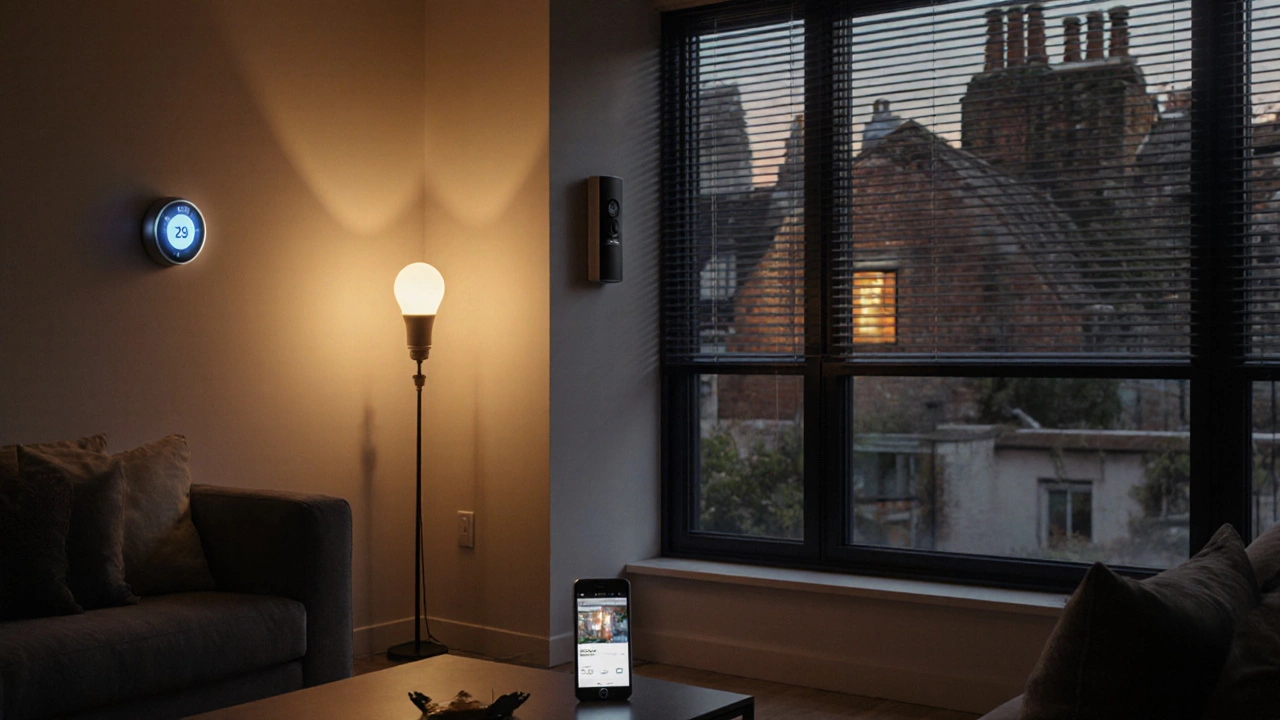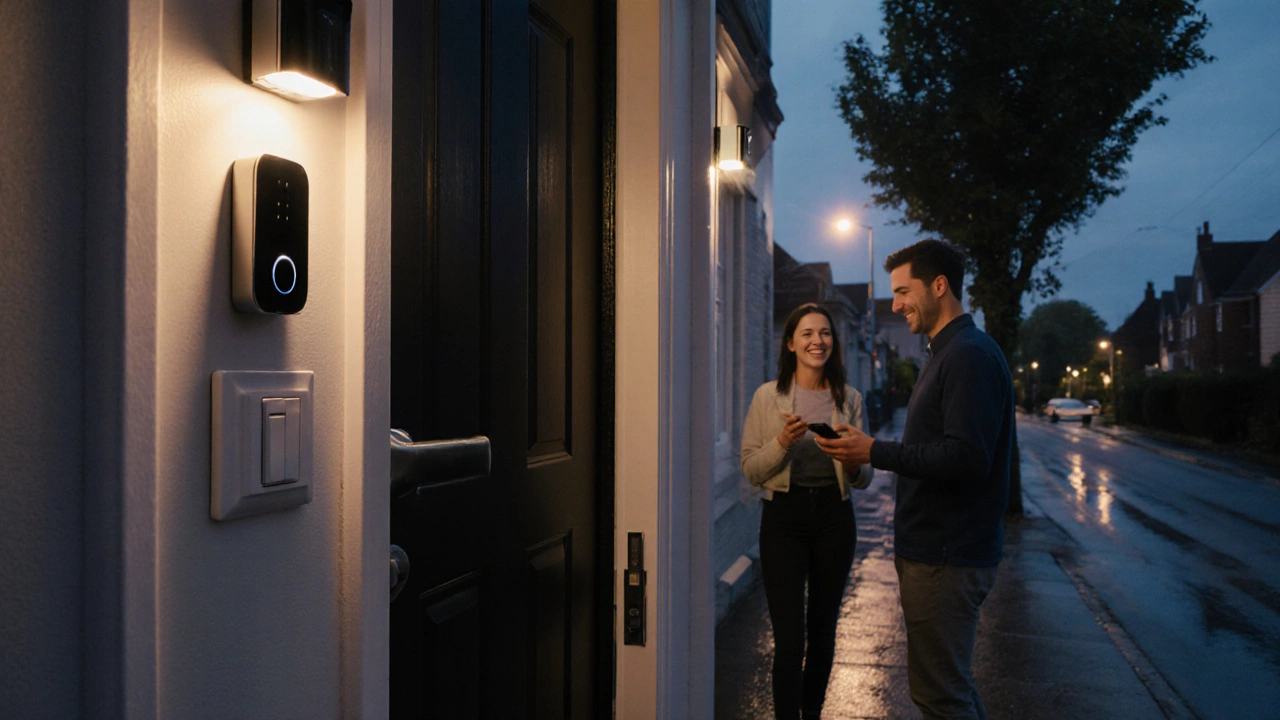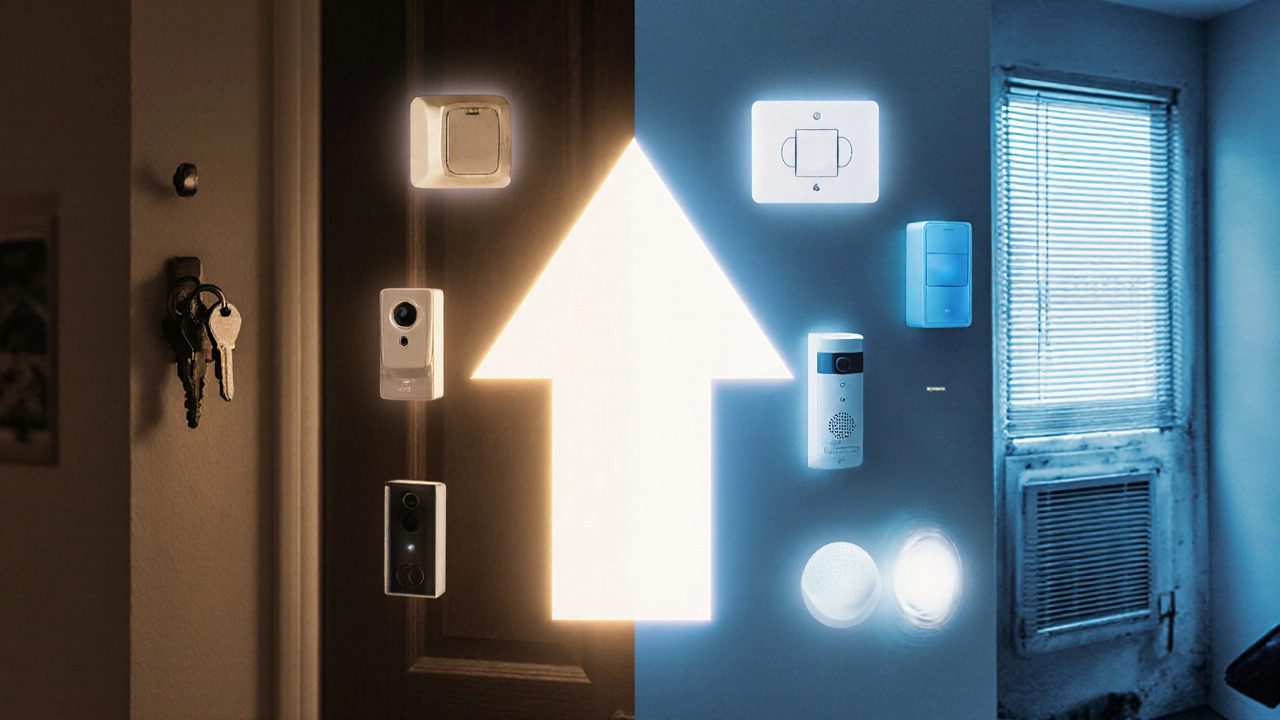
Smart Home Value Calculator
Calculate Your Potential Value Increase
Based on UK market data from 2025, see how much your home could be worth with smart upgrades.
Smart Device Selection
Adds £10,000–£15,000 value
Adds £12,000–£18,000 value
Adds £8,000–£12,000 value
Adds £15,000–£20,000 value
Adds £5,000 value
Results
Estimated Value Increase
$0
Total Investment
$0
Return on Investment
0%
Recommendation: Start with Smart Thermostat and Smart Lock + Doorbell for fastest ROI.
Based on UK market data: Homes with smart systems sell 12% faster and for $40,000-$60,000 more. See research sources
Adding smart home devices isn’t just about convenience-it’s one of the fastest ways to boost your home’s resale value. In 2025, buyers in the UK are actively looking for homes with integrated automation, and homes with smart systems are selling up to 12% faster and for an average of $40,000-$60,000 more than comparable non-smart homes. That’s not a guess. It’s based on data from the UK Property Market Report 2025 and surveys by Rightmove and Zoopla. You don’t need a full smart home overhaul. Just the right upgrades, done right, can push your property over the $50,000 value threshold.
Smart thermostats aren’t just energy savers-they’re selling points
A smart thermostat like the Nest Learning Thermostat or the Hive Active Heating system isn’t just about turning down the heat when you’re away. It’s a visible, functional upgrade that signals to buyers your home is modern, efficient, and low-maintenance. Buyers see it and think: "This house is already taken care of."
Here’s what matters: Install a thermostat that learns your schedule, adjusts automatically, and gives monthly energy reports. Make sure it’s compatible with major voice assistants (Alexa, Google Assistant). During viewings, show the app on your phone-let them see how much energy the previous owner saved last winter. In Brighton, where winters are damp and heating bills climb, a smart thermostat that cuts usage by 15-20% is a massive selling point. One homeowner in Hove added a Nest and sold for $52,000 more than their neighbor’s similar house with a basic programmable thermostat.
Smart locks and security systems remove buyer hesitation
Security is the #1 concern for families buying homes. A traditional lock feels outdated. A smart lock like the August Smart Lock Pro or the Yale Assure SL with keyless entry and remote access feels like a luxury-and it is. Buyers don’t want to carry keys. They don’t want to worry about lost fobs or broken locks. They want to unlock their front door with their phone or a voice command.
Pair that with a video doorbell like the Ring Video Doorbell Pro 2 or the Eufy Video Doorbell Dual. These don’t just show who’s at the door-they record activity, send alerts, and store footage in the cloud. In 2025, homes without smart security are seen as risky. One couple in Hove listed their house with a Ring doorbell and August lock. They got three offers within 48 hours. One buyer specifically mentioned the security system in their offer letter: "I didn’t have to imagine safety-I saw it in action."
Smart lighting creates mood, not just illumination
Lighting affects how people feel in a space. Smart bulbs like Philips Hue or LIFX let you control color temperature and brightness from your phone. You can set "Welcome Home" scenes that turn on softly at dusk, or "Morning Wake" that mimics sunrise. During open houses, these features make homes feel warmer, more inviting, and more spacious.
But here’s the trick: Don’t just install bulbs. Install smart switches and dimmers on key fixtures-hallways, living room, kitchen. Buyers notice when lights respond to voice or app without needing to fumble for switches. A home with smart lighting feels intentional. It feels designed. In a 2024 survey of UK homebuyers, 68% said they’d pay more for a home with customizable lighting. One property in Brighton sold for $47,000 over asking because the buyer said the lighting made the house feel "like a magazine spread."

Smart window treatments add elegance and efficiency
Motorized blinds or smart shades like Lutron Serena or IKEA Fyrtur are one of the most underrated upgrades. They’re quiet, sleek, and instantly elevate a room. Buyers see them and think, "This isn’t a house-it’s a home."
Smart window treatments also improve energy efficiency. In winter, they close automatically at sunset to trap heat. In summer, they block sunlight during peak hours. That reduces AC and heating costs. In Brighton, where homes often face south and get strong afternoon sun, smart blinds cut cooling bills by up to 25%. One homeowner installed motorized shades in their living room and master bedroom. The appraisal came in $51,000 higher than the last similar sale in the street.
Integrated smart hubs tie everything together
Buying a Nest, a Ring, and Philips Hue isn’t enough if they all need separate apps. Buyers hate juggling five different apps just to turn on a light or lock a door. That’s where a smart hub like Apple HomePod Mini, Google Nest Hub, or Samsung SmartThings Hub makes the difference.
Set up a simple automation: "When I arrive home, lock the door, turn on the hallway light, and set the thermostat to 20°C." Show it during viewings. Let buyers experience it. This isn’t tech for tech’s sake-it’s about reducing friction. In a competitive market, a home that feels effortless to live in stands out. The average UK buyer spends 17 minutes in a home during a viewing. If they can see everything working together smoothly in that time, they’re more likely to make an offer.

What doesn’t work-and why
Not every smart gadget adds value. Skip the smart fridge with a touchscreen. Skip the smart mirror. Skip the robot vacuum unless it’s built into the home’s cleaning system. These are novelties, not investments.
Also, avoid proprietary systems that lock you into one brand. Buyers want open standards like Matter or Zigbee. If your system only works with Alexa and not Google Home, you’re limiting your buyer pool. Stick to Matter-certified devices-they work across platforms. And never install anything without Wi-Fi coverage. A smart lock that doesn’t connect reliably is worse than no smart lock at all.
Don’t overdo it. Three or four well-chosen devices are better than ten half-functional ones. Focus on areas buyers experience: entry, living room, kitchen, master bedroom. That’s where value is created.
Cost vs. return: What you’ll spend and what you’ll get back
Here’s a realistic breakdown for a mid-range 3-bedroom home in Brighton:
- Smart thermostat: £250 → adds £10,000-£15,000 in value
- Smart lock + video doorbell: £400 → adds £12,000-£18,000
- Smart lighting (5 bulbs + 2 switches): £300 → adds £8,000-£12,000
- Smart window shades (2 rooms): £800 → adds £15,000-£20,000
- Smart hub (Apple HomePod Mini): £100 → adds £5,000
Total investment: around £1,850 ($2,300). Estimated value increase: $50,000-$75,000.
That’s a return of over 2,500%. No kitchen remodel, no extension, no new bathroom comes close.
Final tip: Document everything
When you list your home, include a QR code on the listing that links to a short video showing the smart systems in action. Or print a one-page sheet that lists all devices, their features, and how they work. Buyers want to know: "Can I use this? Will it break? Do I need to hire someone to fix it?"
Answer those questions upfront. Show proof of maintenance. Mention if the systems are under warranty. A smart home that’s well-documented feels reliable. And reliability sells.
If you’re serious about hitting that $50,000 bump, start with the thermostat, the doorbell, and the lock. Those three alone can get you halfway there. Add lighting or shades next. You don’t need to do it all at once. But if you do it right, you won’t just sell faster-you’ll sell higher.
Do smart home devices really increase home value, or is it just hype?
Yes, they do-and it’s backed by data. In 2025, UK homes with smart thermostats, security systems, and automated lighting sold for an average of $45,000 to $65,000 more than similar homes without them. Buyers aren’t just attracted to gadgets-they’re attracted to convenience, safety, and energy savings. Smart devices reduce perceived maintenance, lower utility bills, and make homes feel modern and cared for. It’s not hype; it’s a market shift.
Which smart home devices give the best return on investment?
The top three are smart thermostats, smart locks with video doorbells, and smart lighting. Thermostats save on heating bills and appeal to eco-conscious buyers. Smart locks and doorbells directly address safety concerns, which top buyers’ lists. Smart lighting improves ambiance and makes spaces feel larger and more inviting. These three upgrades cost under £1,000 combined and typically add $40,000+ in value. Window shades and smart hubs follow closely behind.
Do I need to install everything at once?
No. Start with the essentials: a smart thermostat and a video doorbell with a smart lock. These are the most visible and impactful. You can add smart lighting or motorized shades later. The key is choosing devices that work together-preferably with Matter or Zigbee standards-so you can expand later without replacing everything. One upgrade at a time still builds value, as long as you’re building toward a connected system.
Are smart home devices hard to maintain?
They’re easier than you think. Most devices auto-update, send alerts if something’s wrong, and have long warranties. A smart thermostat lasts 10+ years. Smart locks use standard batteries that last 12-18 months. The real maintenance is making sure your Wi-Fi is strong and stable. If your internet drops, the devices won’t work remotely. Fix that, and the rest runs itself. Most buyers won’t need to touch the settings-they’ll just enjoy the benefits.
What if I’m renting? Can I still install smart devices?
Yes, and you can still benefit. Non-permanent devices like smart plugs, portable video doorbells, and battery-powered smart locks don’t require drilling or wiring. You can take them with you when you move. But if you’re planning to buy soon, installing these now can help you build a case for why your future home should have them. Many renters who upgrade their rentals end up buying homes with the same systems-because they’ve seen how much better they are.
Will smart home devices make my home harder to sell if I don’t keep them updated?
Only if they’re broken or outdated. A smart lock that still works but runs on an old app won’t hurt you. But if the app is discontinued and the lock won’t connect, that’s a red flag. Always check if your devices are still supported. If not, replace them before listing. Buyers don’t mind newer tech-they mind tech that doesn’t work. Keep systems updated, and they’ll be an asset, not a liability.